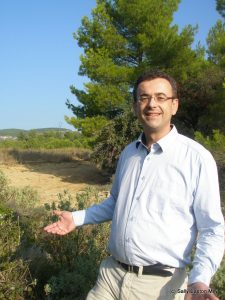Château Massamier La Mignarde

Frantz Vènes talks La Livinière terroir
Frantz Vènes is no newcomer to the Languedoc. The now 70 hectare Château Massamier La Mignarde, in the Minervois, has been in the family for 300 years.
Minervois is an appellation based mainly on syrah, grenache and mourvèdre. Vènes also grows carignan and cinsault. But because it heads into the foothills of the mountains, Vènes said the cooler air keeps the syrah in a fruity rather than spicy genre, adding Minervois is fresher than some other appellations – “there is fresh air from the Black Mountain, which is part of the Cevennes”, and the growing season diurnals are argued to help too. In summer he said “there can be 20°C difference between the day and night time temperature.”
In the winery, Vènes is a fan of carbonic maceration. Just the Cuvée Aubin had 50% carbonic maceration with the rest using de-stemmed fruit in a traditional vinification. “We like the results” of carbonic maceration, he said “the fruit, the structure, the volume. This fermentation is interesting because it gives more volume. But the grape terroir smell also comes through”. The wines are generally left under carbonic maceration for two to three weeks, then pressed to vat for blending and then into old (or new) oak barrels for maturation.
Of the carbonic maceration technique Vènes emphasised “we never put the grenache in the tank alone, because the stems are green. We always blend in the tank with syrah. Syrah goes in first, then grenache.” This ensures fermenting juice at the bottom of the tank does not come into direct contact with the grenache stems.
Minervois was the first of the Languedoc appellations to achieve a cru status for part of its territory. The cru Minervois La Livinière was achieved in 1998. Named after the village of the same name, this cru lies at the end of Minervois “at the border of the mountain, on very poor soil” Vènes said, on the slopes of the Petit Causse, at the foot of the Black Mountain.
He said “the history of La Livinière is that we made good wine here because we could not produce big quantities, as you can near the sea.” And he said, “in the 70s and the beginning of the 80s there were only two or three producers asking INAO for the appellation. It took 20 years.”
Now La Livinière is being put forward for Languedoc Grand Cru status. Vènes said “we’re not grand cru, but we could be in 2 or 40 years”, suggesting the process is somewhat unpredictable.
Tasting, in situ, October 2012
Château Massamier la Mignarde, Cuvée Aubin 2009, Minervois, ~ £11
50% grenache, 25% syrah, 25% carignan. 12 months in ex-Domus Maximus French oak barrels. Carbonic maceration done on half of each of the three grape varieties.
Aromatic, liquorice confectionary (rather than root), dark berries with silky smooth texture, bright and crunchy fruit.
Château Massamier la Mignarde, Domus Maximus 2009, Minervois La Livinière, €40
80% syrah, 20% grenache. More than 20 days of carbonic maceration then 12 months of ageing in new French oak barrels. 15%.
Juicy, jammy (in a fresh, not stewed sense) red berries, with silky tannins, mulberry, blueberry, raspberries with chewy young tannins hitting on the mid palate. Full body, very smooth and quite luxurious on the mid palate. Sweet, fresh balance, plush texture, really good.
Château Massamier la Mignarde, Tènement des Garouilhas 2009, Minervois La Livinière €60
60% syrah, 20% carignan, 20% grenache. Three weeks of carbonic maceration followed by 18 months in new oak barrels.
Spicy, tarry spice. Feel the 16% on the attack (only). Then feel smooth, sweet fruit. Retains a real freshness despite the alcohol. Rich in dark berry fruits, black and blueberry. Big wine, with huge volume in the mouth. Alcohol is integrated by the back palate leaving the tastes of plentiful sweet fruit, very fine-textured silty tannins, plus the sandalwood grain of oak tannin. Good.
My visit to the Languedoc in October 2012 was sponsored by a group of half a dozen producers.



